* You are viewing Posts Tagged ‘Women’
James Brown
November 30, 2012
Calls for Papers, Conferences and Workshops, Events, Projects and Centres
Tags: Book History, Diplomatic History, Gender, Global, History of Scholarship, History of Science, Networks, Religion, Women
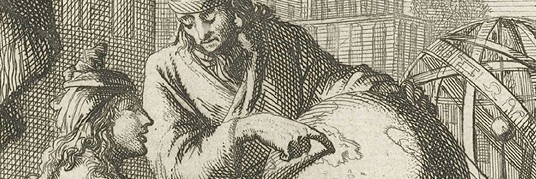 The Centre for Seventeenth-Century Studies at Durham University is seeking papers for a conference on Intellectual Networks in the Long Seventeenth Century (30 June–2 July 2013). The event – which will feature a keynote lecture from our own Howard Hotson – will ‘explore the emergence and consolidation of systems of intellectual and cultural exchange during the long seventeenth century, while assessing their lasting influence on the history of scholarship, literature, diplomacy, science, and religious communities’. Proposals are encouraged on (inter alia) erudite correspondence; academic networks; diplomacy; literary circles; intellectual exchange within religious communities; the book trade; women and intellectual exchange; and popular cultural exchange.
The Centre for Seventeenth-Century Studies at Durham University is seeking papers for a conference on Intellectual Networks in the Long Seventeenth Century (30 June–2 July 2013). The event – which will feature a keynote lecture from our own Howard Hotson – will ‘explore the emergence and consolidation of systems of intellectual and cultural exchange during the long seventeenth century, while assessing their lasting influence on the history of scholarship, literature, diplomacy, science, and religious communities’. Proposals are encouraged on (inter alia) erudite correspondence; academic networks; diplomacy; literary circles; intellectual exchange within religious communities; the book trade; women and intellectual exchange; and popular cultural exchange.
The deadline for proposals for 20-minute papers and full panels is 15 January 2013. For further details and submission instructions, head along to the conference webpage or download the flyer (pdf).
James Brown
September 24, 2012
Events, Exhibitions, Lectures, Project Updates
Tags: Animals, Book History, Conchology, Gender, History of Science, Illustration, Martin Lister, Natural History, Seventeenth Century, Women
Post updated to include photographs
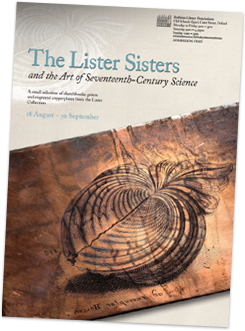 Our Martin Lister Research Fellow Anna Marie Roos has curated a small exhibition entitled ‘The Lister Sisters and the Art of Seventeenth-Century Science’, which will run in the Proscholium of the Old Bodleian Library from 18 August to 30 September (the poster can be downloaded here [pdf]). The free display showcases a unique set of drawings, prints, and copperplates of molluscs and their shells, (re)discovered among the library’s holdings by Anna Marie in 2010, which formed the basis for the illustrations in Martin Lister’s conchological magnum opus, the Historiae Conchyliorum (1685-92). Prepared by Lister’s teenage daughters, Susanna and Anna, the materials shed light on representational conventions within late seventeenth-century natural history, as well as on the gendered nature of illustrative practice in this boom era for lavishly illuminated scientific books. Anna Marie will also be giving a free lecture on ‘The Art of Science: The Rediscovery of the Lister Copperplates’ at 1pm on Wednesday 19 September in the Bodleian’s Convocation House (more info and booking on the library website). Further details of both events on The Conveyor.
Our Martin Lister Research Fellow Anna Marie Roos has curated a small exhibition entitled ‘The Lister Sisters and the Art of Seventeenth-Century Science’, which will run in the Proscholium of the Old Bodleian Library from 18 August to 30 September (the poster can be downloaded here [pdf]). The free display showcases a unique set of drawings, prints, and copperplates of molluscs and their shells, (re)discovered among the library’s holdings by Anna Marie in 2010, which formed the basis for the illustrations in Martin Lister’s conchological magnum opus, the Historiae Conchyliorum (1685-92). Prepared by Lister’s teenage daughters, Susanna and Anna, the materials shed light on representational conventions within late seventeenth-century natural history, as well as on the gendered nature of illustrative practice in this boom era for lavishly illuminated scientific books. Anna Marie will also be giving a free lecture on ‘The Art of Science: The Rediscovery of the Lister Copperplates’ at 1pm on Wednesday 19 September in the Bodleian’s Convocation House (more info and booking on the library website). Further details of both events on The Conveyor.
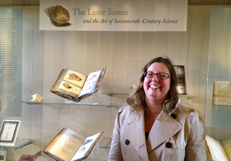
Anna Marie in front of the display

Lecturing in Convocation House
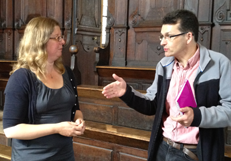
In conversation with Stephen Johnston
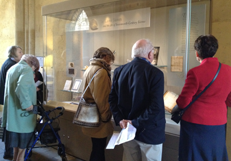
The exhibition proves a hit
Kim McLean-Fiander
July 02, 2012
Events, Lectures, Podcasts, Project Updates, Publications
Tags: Cryptography, Editions, Elizabeth Stuart, Gender, Military History, Politics, Women
 Podcast available on the seminar page!
Podcast available on the seminar page!
Elizabeth Stuart, Queen of Bohemia (1596-1662) has often been portrayed as a romantic and frivolous figure; as a desperate, poverty-stricken, devout widow, or as a dilettante who spent her time going to ballets and masques and keeping the company of monkeys (which she allegedly enjoyed more than that of her children). A key constituent of these narratives has been the assumption that her political influence within Europe was negligible.
However, as Nadine Akkerman of Leiden University argued in her paper in our seminar series on 24 May (Opening up the Winter Queen’s Cabinet: The Correspondence of Elizabeth Stuart, Queen of Bohemia), this is a distorted and partial perception of the monarch that has largely arisen because historians have tended to overlook her vast correspondence. The fact is that Elizabeth’s nearly 1700 surviving letters from forty-seven archives in Europe and the US (estimated to be a mere 10% of what once existed) − which Nadine is editing for OUP − contain almost no information on her cultural life, and very little mention of plays, artists, or poets. They reveal instead that she was immersed in politics and was a keen follower of military affairs. Indeed, the underlying purpose of nearly all of her letters, Nadine argued, was to regain the lost Palatinate lands for her heirs.

Elizabeth, Queen of Bohemia
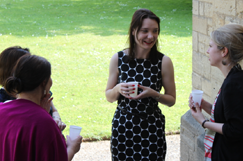
Nadine fields questions over drinks.
In a stimulating and wide-ranging analysis, Nadine discussed the often ignored, though politically important, roles of royal secretaries, scribes, and letter carriers. She traced the various ways by which Elizabeth attempted to outwit her brother Charles I’s surveillance of her correspondence (by using cryptography and steganography, for example), and suggested that Elizabeth used letters as a polite instrument by which to sabotage her brother’s plans for the Thirty Years War, thus making that event last ten years longer than it might otherwise have done. In sum, Nadine posited that an examination of this important though neglected correspondence should bring about an overdue reconfiguration of the Queen of Bohemia’s pivotal role in seventeenth-century diplomatic, military, and political history.
Kim McLean-Fiander
May 13, 2012
Events, Lectures, Podcasts, Project Updates, Projects and Centres, Websites and Databases
Tags: Archives, Bess of Hardwick, Digitization, Editions, England, Gender, Materiality, Sixteenth Century, Women
 Podcast available on the seminar page!
Podcast available on the seminar page!

Alison fields questions.

Bess in the 1590s.
Dr Alison Wiggins of the University of Glasgow got our third seminar series off to a brilliant start on 26 April with a sophisticated and thought-provoking presentation on Editing Bess of Hardwick’s Letters Online. As Principal Investigator of the Letters of Bess Hardwick Project (funded by the AHRC), Alison described the benefits and methodological challenges of digitizing this unique Renaissance correspondence, which consists of approximately 245 extant letters (160 to and 85 from Bess) scattered across 18 different repositories spanning a period of nearly 60 years.
Using several examples drawn from the corpus, Alison argued that making all of the letters available in an open-access, fully searchable online edition will enable scholars to pursue a wide range of linguistic, sociological, and historical questions, and will allow them to arrive at a much more comprehensive and nuanced understanding of the character of Bess herself, who has been variously depicted as a materialistic virago or as an admirable defender of women’s honour.
 Moving on to more methodological questions, Alison explained that capturing and communicating significant information on the material and visual features of letters, such as the writer’s use of ‘significant space’, paper quality and size, the employment of colourful silk ribbons and flosses, seal choice, and the many varieties of folding, can be particularly difficult in a digital environment, which has a tendency to reify disembodied text at the expense of the letter-object (concerns also raised by Henry Woudhuysen and James Daybell in previous talks). This is a significant problem, since such information is not just antiquarian micro-detail; on the contrary, for contemporary recipients, all of these carefully considered material decisions on the part of the sender conveyed specific social meanings about politeness, deference, and hierarchy which set important parameters for the reception and consumption of a letter’s written content. However, such physical variables and their nuances are not easy to capture faithfully with a simple measurement or colour chart reference in a metadata field. The solutions developed by Alison and her team in the context of the Bess project (such as encoding each of the four recognized kinds of letter-fold − tuck and fold, slit and band, accordion, and sewn − within each letter’s XML to facilitate searching and filtering by plicature and packet type) genuinely move forward thinking in this oft-neglected area and will be of great interest to other digital initiatives.
Moving on to more methodological questions, Alison explained that capturing and communicating significant information on the material and visual features of letters, such as the writer’s use of ‘significant space’, paper quality and size, the employment of colourful silk ribbons and flosses, seal choice, and the many varieties of folding, can be particularly difficult in a digital environment, which has a tendency to reify disembodied text at the expense of the letter-object (concerns also raised by Henry Woudhuysen and James Daybell in previous talks). This is a significant problem, since such information is not just antiquarian micro-detail; on the contrary, for contemporary recipients, all of these carefully considered material decisions on the part of the sender conveyed specific social meanings about politeness, deference, and hierarchy which set important parameters for the reception and consumption of a letter’s written content. However, such physical variables and their nuances are not easy to capture faithfully with a simple measurement or colour chart reference in a metadata field. The solutions developed by Alison and her team in the context of the Bess project (such as encoding each of the four recognized kinds of letter-fold − tuck and fold, slit and band, accordion, and sewn − within each letter’s XML to facilitate searching and filtering by plicature and packet type) genuinely move forward thinking in this oft-neglected area and will be of great interest to other digital initiatives.
Following a brief, appetite-whetting demonstration of the Bess letters alpha software, a lively question and answer session concluded the seminar, which covered such topics as the sociolinguistic significance of employing scribes and the iconographic implications of Bess using her ‘ES’ signature both in letters and as architectural embellishment on her stately home, Hardwick Hall. Broader concerns were also addressed, including the need for digital projects to produce REF-friendly outputs – an increasingly important theme – and ways of ensuring the preservation and accessibility of online resources long after project funding comes to an end. The soon-to-be-released Bess of Hardwick Letters Online will include annotated transcriptions of all of the letters and images of many, as well as articles and podcasts offering further contextual analyses of the correspondence. For news about its release date, stay tuned!
Seminars take place in the Faculty of History on George Street on Thursdays at 3pm. For future talks in the series – and to listen to the podcast of Alison’s paper – please see the seminar webpage. All are welcome!
Kim McLean-Fiander
May 02, 2012
Conferences and Workshops, Events, Project Updates
Tags: Databases, Gender, Hans Sloane, History of Science, Networks, Union Catalogue, Union Catalogue News, Women
I’ve recently returned from the Situating Early Modern Science Networks workshop at the University of Saskatchewan in a chilly but sunny Saskatoon. Hosted by Dr Lisa Smith (who we met when she gave an excellent paper on Hans Sloane’s correspondence in our 2011 seminar series), the two-day event (12-13 April) saw scholars from the UK, Canada and the US – generously funded by the conference – speak about early modern networks from a wide range of disciplinary perspectives, including English, History, and the History of Science.
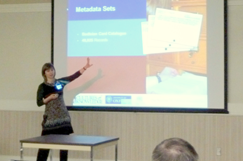
Introducing the catalogue.
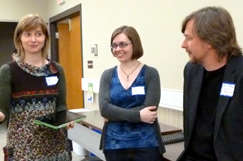
Post-presentation discussion.
My paper ‘Digitizing Gender: Women’s Correspondence and Knowledge Networks in the Early Modern Era’ focused on the ideological and technical challenges of digitizing gender, including the so-called ‘digital gender ghetto’ wherein data on early modern women is only collected and made accessible within gender-specific online silos. Such resources, while valuable, raise methodological and conceptual difficulties; not only does the information they contain often get bypassed by large portions of the scholarly community, but the long-standing trope that early modern women occupied a hermetically sealed separate sphere is implicitly reinforced, sustaining unhelpful assumptions that they were not fully engaged in intellectual or public life. To overcome this predicament, I suggested that we need to develop digital systems which can link or speak to each other so that data on men and women can be interrogated simultaneously. By doing this, the role played in early modern knowledge communities by individuals such as Katherine Jones, Lady Ranelagh, or Dorothy Moore Dury, for example, can be properly assessed and appreciated within a wider network of both male and female individuals and correspondents.

The ‘Digital Coffee House’.
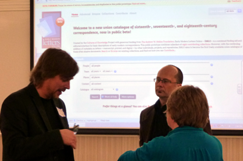
EMLO on the big screen.
The potential for online resources to facilitate and manifest these kinds of connections became clear during the hands-on ‘Digital Coffeehouse’ portion of the workshop, during which participants were introduced to the following array of early modern digital resources: The Digital Ark, The Newton Project, The Sloane Printed Books Project, The Grub Street Project, The Textual Communities Project, Digital MappaeMundi, and our own Early Modern Letters Online. Future digital collaborations may well result! The conference was rounded out with a thought-provoking talk by Professor Robert Iliffe on the implications for scholarly work arising from the increasing digitization of the academic infrastructure. His presentation sparked a lively debate during the roundtable discussion on the future of online scholarship which covered how the UK’s REF (Research Excellence Framework) assessments handle digital humanities outputs; the ownership of digital materials; concerns about scholars losing old skills and values in favour of new ones; and a consideration of the perils and benefits of crowdsourcing.
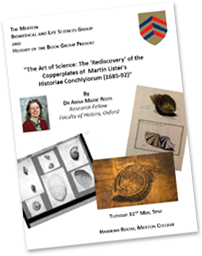 Post edited to add photographs
Post edited to add photographs
A lecture by our Martin Lister Research Fellow Dr Anna Marie Roos on ‘The Art of Science: The ‘Rediscovery’ of Martin Lister’s Historiae Conchyliorum (1685-92)’ will take place at 5pm on Tuesday 31 May in the Hawkins Room of Merton College. The event is a joint meeting of the Merton Biomedical and Life Sciences and History of the Book research groups. Anna Marie is a leading authority on the history of science and medicine in early modern England. Alongside her work for Cultures of Knowledge (for which she is editing Lister’s correspondence), she has published widely in the history of chemistry, as well as on magic and astrological medicine. Her talk will focus on the stunning series of copperplates created by Lister’s teenage daughters to illustrate his groundbreaking compendium of shells, the rediscovery of which last year aroused a great deal of interest.

Anna Marie during her talk.
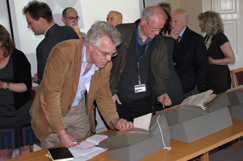
Listerian material from Merton’s holdings.
 The Centre for Seventeenth-Century Studies at Durham University is seeking papers for a conference on Intellectual Networks in the Long Seventeenth Century (30 June–2 July 2013). The event – which will feature a keynote lecture from our own Howard Hotson – will ‘explore the emergence and consolidation of systems of intellectual and cultural exchange during the long seventeenth century, while assessing their lasting influence on the history of scholarship, literature, diplomacy, science, and religious communities’. Proposals are encouraged on (inter alia) erudite correspondence; academic networks; diplomacy; literary circles; intellectual exchange within religious communities; the book trade; women and intellectual exchange; and popular cultural exchange.
The Centre for Seventeenth-Century Studies at Durham University is seeking papers for a conference on Intellectual Networks in the Long Seventeenth Century (30 June–2 July 2013). The event – which will feature a keynote lecture from our own Howard Hotson – will ‘explore the emergence and consolidation of systems of intellectual and cultural exchange during the long seventeenth century, while assessing their lasting influence on the history of scholarship, literature, diplomacy, science, and religious communities’. Proposals are encouraged on (inter alia) erudite correspondence; academic networks; diplomacy; literary circles; intellectual exchange within religious communities; the book trade; women and intellectual exchange; and popular cultural exchange.







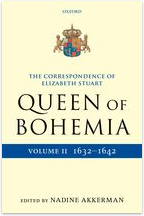


 Moving on to more methodological questions, Alison explained that capturing and communicating significant information on the material and visual features of letters, such as the writer’s use of ‘significant space’, paper quality and size, the employment of colourful silk ribbons and flosses, seal choice, and the many varieties of folding, can be particularly difficult in a digital environment, which has a tendency to reify disembodied text at the expense of the letter-object (concerns also raised by
Moving on to more methodological questions, Alison explained that capturing and communicating significant information on the material and visual features of letters, such as the writer’s use of ‘significant space’, paper quality and size, the employment of colourful silk ribbons and flosses, seal choice, and the many varieties of folding, can be particularly difficult in a digital environment, which has a tendency to reify disembodied text at the expense of the letter-object (concerns also raised by 







 Join
Join 